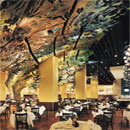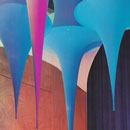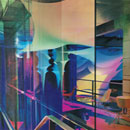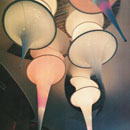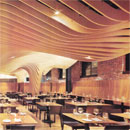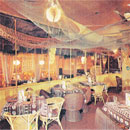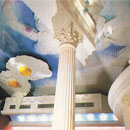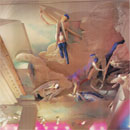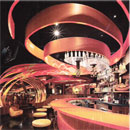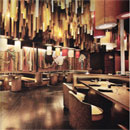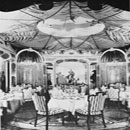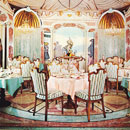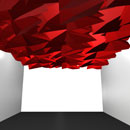
Dressed Ceiling
Dressed Ceiling describes the treatment of large sections of a ceiling plane that is dressed by three-dimensional materials or objects that enliven the plane in terms of decoration or ornamentation. more
Dressed Ceiling | Theme Dining
application
Dressed Ceiling contributes to, and/or extends, a particular themed setting by expanding upon the notions of theatricality, use of props, and cultural appropriations.
research
The decoration and enhancement of the overhead plane has pervasive effects in the overall ambiance of a space.1 In theme dining settings, the ornamentation of the ceiling can be characterized as an attempt by the designer to visually and psychologically reinforce the thematic scheme used throughout a dining venue. It may also assist in the creation of particular points of interest or emphasis in the space. By bringing an awareness of what is above, the dining experience becomes an all encompassing sensory experience, and may be more successful in the delivery of a theme and sensorial understanding of it.
Dressed Ceiling employs a variety of materials and mediums to create three-dimensional forms to make the ceiling a manifestation of a theme. It may create feelings of seclusion, openness, intimacy, or high energy in the space. On the ceilings, surface articulations are such that, "our perception of the shape, size, scale, proportion, and visual weight of a plane is influenced by its surface properties as well as its visual context." A Dressed Ceiling has the ability to influence the adjacent vertical planes and the ground surrounding it, by creating zones of contrast, clarifying or distorting shapes, colors, and volumes.2
In architecture and design theory, "when we place a two-dimensional figure on a piece of paper, it influences the shape of the white space around it. In a similar manner, any three-dimensional form naturally articulates the volume of space surrounding it and generates a field of influence or territory which it claims as its own."3 Given this premise, the use of three-dimensional objects on the overhead plane in juxtaposition with two-dimensional features, such as surface color and pattern, results in a dynamic engagement with the ground plane and the volume in between. This phenomenon is an activated ceiling.
An activated ceiling can translate into a vibrant and synergistic space that works in concert with the other thematic elements to deliver an exotic and fantastic experience that elevates the patron's experience to all planes of a dining establishment. The shape, size, and height above the ground plane, defines the level of formality of the space. Also color, texture, and the pattern of the ceiling can be manipulated to improve the quality of light and sound within a space. "The ceiling plane of an interior space doesn't need to carry weight loads or weather the elements, it can be detached from the roof plane and become a visually active element in the space."4
Historically, ceilings have been an important architectural element for the display of art, especially paintings. In many religions, the ceiling is an equivalent heaven. Thus, the many churches and temples around the world place the ceiling at great heights. The height of the ceiling in comparison to the scale of a person signifies the majesty and greatness of a creator. Countless examples exist in history and painted ceilings date as far back as 40,000 years. Painted ceilings bring attention and importance to the space above human interactions.
Indeed, the correlation between Dressed Ceilings and art forms is evident in the photographic analysis of this chapter. Specifically, Dressed Ceilings are an expression of installation art, this is understood as "the type of art into which the viewer physically enters, and which is often described as 'theatrical,' 'immersive,' or 'experiential.' Installation art has as primary purpose "to heighten the viewer's awareness of how objects are positioned (installed) in a space, and of our bodily response to this."5 Given this definition, it is only natural to infer that Dressed Ceilings create experiential sequences to invoke the theme for those who dine at this type of food establishments.
The implementation of three-dimensional features on the overhead plane in theme dining begins with Polynesian theme restaurants. One of the most widely known of these establishments is Clifton's, located in Los Angeles. Although it first opened its doors in 1931, it was not until 1939 that it acquired its Polynesian interior. The postcard titled Rain Hut Party6 depicts a ceiling made of grasses and fibers from palm trees. A post-and-beam structure hold up the roof and ceiling, to provide an enlivened space in the interior of the hut. Vines and plants hang from the ceiling as well as traditional water vessels or receptacles. In this rain hut, a special effect "rainstorm" occurs every twenty minutes. The rain hut is a space-within-a-space located in the larger space of the restaurant. The materiality and decorations on the ceiling creates a sense of distinctiveness for the diners seated below, and the materials aid in the execution and delivery of the Polynesian theme.
Also in the 1940 decade, the Knickerbocker Grill,7 a Chinese and American restaurant, made use of the ceiling as a way to convey the thematic experience in the space. This restaurant delivers the theme by creating an extraordinary ceiling expression with hundreds of yards of fabric draped on the entire ceiling of the restaurant. Elegantly swagged and gathered at strategic points, the fabric in the colors of peach, pale rose, and bisque, create a cloud-like effect. By bringing the ceiling height down, the fabric swags facilitate a more intimate atmosphere, while helping to reduce echo and acoustic noise.
The Decade of 1960
The 1962, Café Tiepelo uses a similar approach by creating a tented fabric ceiling. The café, described in the Interior Design article as "Venetian Baroque", features marble floors, painted murals on the walls, and soft apricots, jades, and ecru as the color palette.8 The room is circular in shape, with tables located around the exterior curvature, and a center table. Anchored by an equally round tented ceiling, all the gathered fabric is tucked at the center point of the ceiling, where a painted mural of clouds converged. Overall, the effect of the ceiling is to ground the curved planes in the room, and expand the notion of splendor and high style.
In the late part of the 1960s, Dressing Ceiling becomes more complex and elaborate. The materials showed more variation, innovation, and expenditure. For example, in the Club Tropicoro in Puerto Rico, a rainforest ceiling is created as "a jungle of thick foliage and vines." This iteration of Dressed Ceiling is efficiently paired with the Intype Inscape, as a material strategy to recreate El Yunque, a Puerto Rican rainforest. Inscape recreates the jungle in the interior through the use of vegetation and weathered stone and rock,9 Dressed Ceiling provides a robust example of a ceiling that seemed to be alive. Several layers of depth and the intricate use of materials are the responsible factors in the success of this tropical dance club. The fullness of the ceiling and the multiple hanging vines gives the impression of being in closer proximity to the guests. Although there is a large stage for performances, the focus of the space is the overhead plane. In this windowless space with dimmed lights, Dressed Ceiling produces an ambiance of enhanced drama.
The Canteen10 at Spiegel Publishing house is considered one of Verner Panton's biggest and most complete works. The psychedelic themed space, designed between 1968 and 1969, boasts psychedelic rooms of saturated oranges, reds, and purples with three-dimensional plastic foam, fabric covered pyramids protruding down from the ceiling. Panton's walls consist of candy colored circles in a grid pattern of Repeat Repeat.11 The entire effect of similar colors and patterns of the planes invoke Camouflage.12 Everything in the spaces, except the Knoll furniture, was custom-made. This sophistication of the design belies its location-a cafeteria of a workplace.
The Decade of 1970
In 1970, the South Pacific Ports restaurant was a place with a "genuine ambiance," that wanted to "bring the glamour of the South Seas to life." The designer Fred Bush uses "tapa cloths to adorn the walls and fishnet cover the ceiling in a graceful tent-like effect, real grass on the roofs of the huts, and nautical oriental lanterns shed romantic lighting."13 The fishnets on the ceiling contribute to a cohesive south-pacific theme, and they define three different dining sections of the restaurants. The perforated, soft, ethereal quality of the fishnet allows for an informal and casual setting. The fishnets also diffuse light and allow air to percolate freely throughout the space. Furthermore, fishnets made it possible to see through them to the structure and materiality of the restaurant.
The Decade of 1980
The sole example of Dressed Ceiling from the 1980 period is Summum, a 1987 club in Ibiza, Spain that takes a three-dimensional imaginative composition to a new level. An abundance of sculptural work and color are pervasive design solutions that bring this underground establishment to life. Lluis Guell, the designer and conceptual force behind the club, creates a "temple" of Classical columns and entablatures and murals of, a fantasy heaven where its underground location would not detract from patrons experience, "because of its size, color, and light, one would not feel as being underground, but instead would breathe more fancy and freedom than outside." The theme "alludes to archeological flights of fancy, where what is represented may well be the buried history of ancient Mediterranean cultures." Summum's ceilings show extensive sculptural work created by Catalonian artisans shipped to the island of Ibiza. Although the ceiling is already 15 feet high, the overhead plane resembles a dark, turbulent sky that provided added height perception.14 The full-size sculptural angels are sensual and eroticized. The sculptures' body positioning and suggestive accessories brought an aura of sexuality and elevated energy to the space. At Summum's the Dressed Ceiling provides a significant element in the production of spectacle.
The Decade of 1990
The decade of 1990 provides the highest number and the most audacious examples of Dressed Ceilings that are characterized by an extensive use of color, large scale and bold interpretations. Many casino restaurants adopt a hyper-theming approach, expensive and elaborate fantasy worlds, in the hope of drawing more customers and increasing their revenues. An example of such extravagance is America, a restaurant in the New York-New York Hotel and Casino in Las Vegas, Nevada. This restaurant opened to customers in 1997 with its major attraction a ceiling with "an immense freestanding bas-relief map of the United States" with marks of major cities and historical sites. The massive map creates a cavernous feeling in the interior of the space, and because of the varying heights of the ceiling, the customers could enjoy different seating areas defined by height of the overhead plane.15 The three-dimensional map projects beyond the ceiling, gently curving down to become a partial wall. The remaining portion of the ceiling is painted in black which in turn diverted the attention to the three-dimensional ceiling map. The ceiling dominates the space with its large scale, multiplicity of colors, and three-dimensional features, making this Dressed Ceiling the defining theme of the restaurant, where no other design features compete for the attention of the patrons.
In 1999, the Red Sea Star, located a hundred feet from the shore of the Israeli town of Eilat, was promoted as the only restaurant in the world to be submerged twenty feet under water. This unique dining experience begins with a "passage over a bridge to an entry pavilion that hovers just above sea level and houses a lounge, coffee bar, and kitchen. Diners then descend two levels to the bar and dining areas." Because the bar and dining rooms are enclosed spaces, sixty-two acrylic windows reveal the beautiful underwater views. To counterbalance the blue hues of the seawater, the design team chose a warm color palette. The designer, Ayala Serfaty, uses rich yellows, oranges, and reds in the furnishings, finishes, and lighting throughout the restaurant. His concept is to create a floating sensation. The ceiling is finished with plaster and covered with more than "200 elements that looked like enlarged pebbles." Serfaty custom designs the lighting fixtures for the walls and ceiling as silk creations resembling anemones and jelly-fish that "appear to be alive and adrift."16 The ceiling also features windows framing aquatic views. The Red Sea Star offers diners an unique thematic opportunity teat eat beside and below the fish and to enjoy views of sea life.
Club Incognito in Zurich, conceived and designed in 1999 by German architect Gisela Stromeyer, relies on the archetypical practice, Stretch,17 tensile structures that produce simple "complex sculptural forms." Stromeyer uses "white Spandex forms to counterbalance the structure's inherent toughness and organize the space." These forms also create effective spatial zones and act as light fixtures that impart an aura of colorful, ethereal light. The ceiling is comprised of "horizontal forms anchored by wall-affixed hooks; vertical versions, shaped through internal hoops, are suspended by wire." Lighting is an integral part of this spatial experience, because the dramatic textile creations are "lit from within by colored lamps". Moreover, the suspended fixtures provide a "vehicle for an ever-changing light show."18
The Decade of 2000
Dramatic ceiling interventions continue unabated in the late part of the 2000 decade and the beginning of the 2010 era. Several three-dimensional ceiling interventions that border on the surreal become the driving force for the thematic dining venues.
The restaurant Banq in Boston opened in 2008 in the 3,500 square-foot space that was the former Penny Savings Bank. Its Dressed Ceiling designed by Office Da principals Nader Tehrani and Monica Ponce de León defies notions of what a ceiling can be. The ceiling installation is "a canopy of Baltic birch that resembles a nautilus shell-albeit a magnified, stretched, and abstracted one-concealing plumbing and lighting as it swoops down to encase the columns. Beneath this undulating seascape, bamboo plywood is the unifying medium of choice for flooring, tables, and banquettes." The restaurant is monochromatic in appearance; "the only hint of contrast is Marco Ferreri's black chairs that stand like sleek punctuation marks amid the honey-toned palette."19 The organic woody forms establish a cavernous, warmly enclosing atmosphere.
A year after the Banq restaurant opened in Boston, the nightclub Greenhouse in New York City, rivaled Banq's Dressed Ceiling in an even larger space-6,000 square feet. Antonio Di Oronzo, the principal at Bluarch Architecture + Interiors, designed Greenhouse's Dressed Ceiling as a composition of 5,000 crystal light bulbs resembling glass vials hanging from the ceiling; the bulbs reflect and emit light, pulsating to the rhythm of the music. A profusion of small disks, some covered in eco-friendly vinyl, others sprouting tufts of faux boxwood, and the rest lacquered and fitted with LED lights throb in patterns according to commands from a digital driver.20
In 2009, the Japanese-Brazilian fusion restaurant, Sushi Samba Strip and Sugarcane Lounge in Las Vegas, welcomed its customers with two lively Dressed Ceilings. In the bar area, ICrave Design created a "ceiling populated by ribbons of glass-reinforced-gypsum-board, and tubes of acrylic, bamboo, or copper."21 The exaggerated ribbons on the ceiling take over a large portion of the bar area, and hover over the heads of guests as an ever-present entity. The forms of the tangerine/red ribbons, when seen against the black-painted ceiling, animate the space, striking a dramatic contrast between the colors and the scale. One of the ribbons curves around the entrance of the dining area to fashion a tunnel-like shape that entices guests to walk further into the restaurant.
In the dining area, another Dressed Ceiling is crafted from hundreds of acrylic tubes of varying lengths and colors that hang from the ceiling.22 Colors range from warm brown, gold, beige, and honey. The reflections of light that come from within the tubes generate a prismatic effect that is intended to dazzle patrons and cocoon them as they dine at dining tables or in booths.
The Decade of 2010
Opening its doors in 2011, What Happens When is the New York City restaurant owned by chef John Fraser. Fraser signed a nine-month lease for a building that was to be demolished in nine months. Deciding to give the restaurant a food, décor and entertainment makeover every thirty days to reinvent a thematic approach, Fraser encouraged diners to cast their votes in the thematic design direction. The bare, black interior space provided a canvas for ever-changing ceiling installations. For Valentine's Day, the "Metrics Design Group hung 400 18-inch-long triangles of a polyester-blend fabric from individual hooks in the ceiling." A "custom chandelier hand-made from cardboard and standard globe fixtures"23 completed the ceiling thematic installation for the month of February. The hot pink gradating to purple installation emitted a defused light that cast a soft glow in the space and on diners.
Conclusion
In published sources, such as Interior Design, Dressed Ceilings in theme restaurants began in the decade of 1940; their start can be characterized as concrete and representational. As the years went by, the use of Dressed Ceiling become more prevalent, and also more elaborate, sophisticated and sensational. The multiple examples of this interior archetype reveal that three-dimensional installations on the overhead plane can define the atmosphere of a single space, or sections of a space, and it can also carry the entire theme itself. Reiterations of Dressed Ceilings in the 2000 and 2010 decades become more akin to art installations that are meant to actively engage diners in dining experiences. The evidence suggests that this practice has reactivated what had become a benign, largely ignored plane. Dressed Ceiling will continue to be widely used by designers, restaurateurs, and developers around the globe as a versatile and high impact strategy to develop and to deliver thematic dining experiences.24
end notes
- 1) The Intype Pendant Play describes the intentional articulation of the ceiling plane with a multitude of lighting fixtures to create a spatial event. Although similar in the aesthetic expression of the ceiling plane, it differs primarily in its functionality. Pendant Play utilizes light as the element to create visual interest in space. Jasmin Cho, "Theory Studies: Archetypical Practices of Contemporary Restaurant Design," (M.A. Thesis, Cornell University, 2009), 87-94; The Interior Archetypes Research and Teaching Project, Cornell University, http://intypes.cornell.edu/intypesub.cfm?inTypeID=83 (accessed May 10, 2012).
- 2) Francis D.K. Ching, Architecture: Form, Space & Order, 2nd Ed. (New York: John Wiley & Sons, Inc.,1996), 88.
- 3) Ching, Architecture: Form, Space & Order, 102.
- 4) Ching, Architecture: Form, Space & Order, 102-03, 122.
- 5) Claire Bishop, Installation Art: A Critical History (New York: Routledge, 2005), 6.
- 6) Postcard, Clifton's "Pacific Seas" [1947] Anonymous Designer; Los Angeles, CA; Anonymous Postcard Manufacturer; PhotoCrd: Anonymous; Private Collection: Jan Jennings.
- 7) Postcard, Knickerbocker Grill, Chinese and American Restaurant [c1940] Anonymous Designer; New York City; E. C. Kropp Co., Postcard Manufacturer; PhotoCrd: Anonymous; Private Collection: Jan Jennings.
- 8) Café Tiepelo [1962] Anonymous Designer; Unknown Location, in Anonymous, "Designs for Dining," Interior Design 33, no. 10 (Oct. 1962): 209; PhotoCrd: Louis Reens.
- 9) Club Tropicoro [1968] Anonymous, architect; San Juan, Puerto Rico, in Anonymous, "Island Hot Spot," Interior Design 39, no.1 (Jan.1968): 98-99; PhotoCrd: Anonymous.
- 10) Spiegel Publishing House Canteen [1969] Verner Panton, design; Hamburg, Germany in Sheila Kim-Jamet, "For the Ages," Interior Design 78, no.3 (Mar. 2007): 388-89; PhotoCrd: Bernadette Grimmenstein.
- 11) The Intype Repeat Repeat is a brand strategy referring to the reiterative use of a graphic element, color application or spatial motif in multiple locations and/or scales within an interior space. This practice is implemented as a means to reinforce an occupant's sense of place and to establish brand identity within the interior. This strategy is generally used in conditions of elevated brand intervention (Activate, Saturate). Juliana Richer Daily, "Spatial Graphic Design: Archetypical Design Practices and Theory Studies on Constructing a Narrative of Place" (M.A. Thesis, Cornell University, 2011), 24; The Interior Archetypes Research and Teaching Project, Cornell University, www.intypes.cornell.edu (accessed May 10, 2012).
- 12) The Intype Camouflage refers to the application of a consistent pattern to the wall, floor, and ceiling planes, as well as furnishings. Wrapping the interior with a continuous pattern effectively blurs the transition between horizontal and vertical planes or between planes and furnishings. Elizabeth O'Brien, "Material Archetypes: Contemporary Interior Design and Theory Study" (M.A. Thesis, Cornell University, 2006), 132; The Interior Archetypes Research and Teaching Project, Cornell University, http://intypes.cornell.edu/intypesub.cfm?inTypeID=7 (accessed May 10, 2012).
- 13) South Pacific Ports Restaurant [1970] Fred Bush, designer; New York City, in Anonymous, "The Glamour of the South Seas," Interior Design 41, no.4 (Apr. 1970): 168-69; PhotoCrd: B & G International.
- 14) Summum's [1987] Lluis Guell, designer; Ibiza, Spain in Edie Lee Cohen, "Summum, Ibiza," Interior Design 58, no. 6 (Apr. 1987): 270-73; PhotoCrd: Jose Pascual.
- 15) America [1997] Turett Collaborative Architects; Las Vegas, Nevada, in Anonymous "Restaurants Step into Design Limelight," Interior Design 68, no.8 (Jun. 1997): 162-66; PhotoCrd: Paul Warchol.
- 16) Red Sea Star Restaurant [1999] Ayala Serfaty Interior Designer; Eilat, Israel in Edie Cohen, "Under the Sea," Interior Design 70, no.9 (Jul. 1999): 142-47; PhotoCrd: Albi Serfaty.
- 17) The Intype Stretch is a tensile structure made from stretched fabric, typically canvas or spandex, with reinforced edges and fastened with hooks, cables, and anchors. Elizabeth O'Brien, "Material Archetypes: Contemporary Interior Design and Theory Study" (M.A. Thesis, Cornell University, 2006), 95; The Interior Archetypes Research and Teaching Project, Cornell University, http://intypes.cornell.edu/intypesub.cfm?inTypeID=39 (accessed May 10, 2012).
- 18) Club Incognito [1999] Gisela Stromeyer Designer, architect; Zurich, Switzerland in Edie Cohen, "Sail Away," Interior Design 70, no.9 (Jul. 1999): 104-09; PhotoCrd: Paul Warchol.
- 19) Banq Restaurant [2008] Office DA, architect; Boston, MA in Marc McMenamin, "Best of Year Formal Dining," Interior Design 79, no.15 (Dec. 2008): 78-79; PhotoCrd: John Horner.
- 20) Greenhouse Nightclub [2009] Antonio Di Oronzo, Bluarch Architecture + Interiors; New York City in Craig Kellogg, "See and Be Green," Interior Design 80, no. 7 (May 2009): 152-54; PhotoCrd: Ado.
- 21) Sushi Samba Strip and Sugarcane Lounge [2009] ICrave Design; Las Vegas, NV in Anonymous, "ICrave Design," Interior Design 80, no. 9 (Jul. 2009): 154-55; PhotoCrd: Francis George and Francis Baytan.
- 22) Sushi Samba Strip and Sugarcane Lounge [2009] ICrave Design; Las Vegas, NV in Anonymous, "ICrave Design," Interior Design 80, no. 9 (Jul. 2009): 154-55; PhotoCrd: Francis George and Francis Baytan.
- 23) What Happens When Restaurant [2011] Metrics Design Group; New York City in Annie Block, "Special of the Month," Interior Design 82, no. 3 (Mar. 2011): 35-36; PhotoCrd: Felix de Voss.
- 24) Evidence for the archetypical use and the chronological sequence of Dressed Ceiling in theme restaurant design was developed from the following sources: 1940 Postcard, Clifton's "Pacific Seas" [1947] Anonymous Designer; Los Angeles, CA; Anonymous Postcard Manufacturer; PhotoCrd: Anonymous; Private Collection: Jan Jennings; Postcard, Knickerbocker Grill, Chinese and American Restaurant [c1940] Anonymous Designer; New York City; E. C. Kropp Co., Postcard Manufacturer; PhotoCrd: Anonymous; Private Collection: Jan Jennings / 1960 Café Tiepelo [1962] Anonymous Designer; Unknown Location, in Anonymous, "Designs for Dining," Interior Design 33, no. 10 (Oct. 1962): 209; PhotoCrd: Louis Reens; Club Tropicoro [1968] Anonymous Designer; San Juan, Puerto Rico in Anonymous, "Island Hot Spot," Interior Design 39, no. 1 (Jan.1968): 99; PhotoCrd: Anonymous; Spiegel Publishing House Canteen [1969] Verner Panton, designer; Hamburg, Germany in Sheila Kim-Jamet, "For the Ages," Interior Design 78, no. 3 (Mar. 2007): 388; PhotoCrd: Bernadette Grimmenstein; Spiegel Publishing House Canteen [1969] Verner Panton, designer; Hamburg, Germany in Sheila Kim-Jamet, "For the Ages," Interior Design 78, no. 3 (Mar. 2007): 389; PhotoCrd: Bernadette Grimmenstein / 1970 South Pacific Ports Restaurant [1970] Fred Bush, designer; New York City in Anonymous, "The Glamour of the South Seas," Interior Design 41, no. 4 (Apr. 1970): 169; PhotoCrd: B & G International / 1980 Summum's [1987] Lluis Guell, designer; Ibiza, Spain in Edie Lee Cohen, "Summum, Ibiza," Interior Design 58, no. 6 (Apr.1987): 270; PhotoCrd: Jose Pascual; Summum's [1987] Lluis Guell, designer; Ibiza, Spain in Edie Lee Cohen, "Summum, Ibiza," Interior Design 58, no. 6 (Apr.1987): 271; PhotoCrd: Jose Pascual / 1990 America [1997] Turett Collaborative Architects; Las Vegas, NV in Anonymous, "Restaurants Step into Design Limelight," Interior Design 68, no. 8 (Jun. 1997):163; PhotoCrd: Paul Warchol; Sea Star Restaurant [1999] Ayala Serfaty Interior Designer; Eilat, Israel in Edie Cohen, "Under the Sea," Interior Design 70,no.9(Jul. 1999): 143; PhotoCrd: Albi Serfaty; Red Sea Star Restaurant [1999] Ayala Serfaty Interior Designer; Eilat, Israel in Edie Cohen, "Under the Sea," Interior Design 70,no. 9 (Jul. 1999): 144; PhotoCrd: Albi Serfaty; Club Incognito [1999] Gisela Stromeyer Designer; Zurich, Switzerland in Edie Cohen, "Sail Away," Interior Design 70, no. 9 (Jul.1999): 105; PhotoCrd: Paul Warchol; Club Incognito [1999] Gisela Stromeyer Designer; Zurich, Switzerland in Edie Cohen, "Sail Away," Interior Design 70, no. 9 (Jul.1999): 106; PhotoCrd: Paul Warchol; Club Incognito [1999] Gisela Stromeyer Designer; Zurich, Switzerland in Edie Cohen, "Sail Away," Interior Design 70, no. 9 (Jul.1999): 108; PhotoCrd: Paul Warchol / 2000 Banq Restaurant [2008] Office DA, architect; Boston, MA in Marc McMenamin, "Best of Year Formal Dining," Interior Design 79, no. 15 (Dec. 2008): 79; PhotoCrd: John Horner; Greenhouse Nightclub [2009] Antonio Di Oronzo, Bluarch Architecture + Interiors; New York City in Craig Kellogg, "See and Be Green," Interior Design 80, no. 7 (May 2009): 154; PhotoCrd: Ado; Sushi Samba Strip and Sugarcane Lounge [2009] ICrave Design; Las Vegas, NV in Anonymous, "ICrave Design," Interior Design 80, no. 9 (Jul. 2009): 154; PhotoCrd: Francis George and Francis Baytan; Sushi Samba Strip and Sugarcane Lounge [2009] ICrave Design; Las Vegas, NV in Anonymous, "ICrave Design," Interior Design 80, no.9 (Jul. 2009): 155; PhotoCrd: Francis George and Francis Baytan / 2010 What Happens When Restaurant [2011] Metrics Design Group; New York City in Annie Block, "Special of the Month," Interior Design 82, no. 3 (Mar. 2011): 35; PhotoCrd: Felix de Voss.
bibliographic citations
1) Roses-Sierra, Jimena. "Theory Studies: Archetypical Theme Dining, Practices in Contemporary Interior Design." M.A. Thesis, Cornell University, 2012, 95-123.

